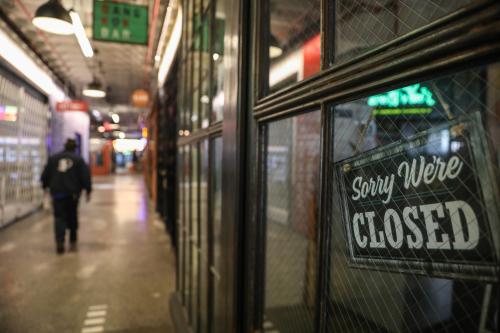April 10, 2020 – This article has been edited from a previous version following reviewer comments from Gary Burtless. This version clarifies BLS’s past and current efforts to classify temporarily unemployed workers and updates figures and discussion to reflect the March employment release, which was not available at time of writing. The author is grateful to Gary Burtless for his helpful comments.
An estimated 46 million Americans have already been laid off or seen a reduction in hours as a result of COVID-19, according to Gallup survey data collected from March 27 to March 31, 2020. This amounts to around 28% of workers.
But these massive losses are unlikely to fully register in the headline numbers from our federal agencies that are usually the subject of media reports. The Gallup data suggest that several million people laid off or facing reduced hours will not be officially considered unemployed by the Bureau of Labor Statistics (BLS) because they are not actively looking for work or do not otherwise meet traditional BLS criteria for unemployment. BLS data will still be highly valuable, but analysts and journalists will need to go beyond the standard unemployment rate to understand the scale of what is happening. The BLS, itself, will need to adjust its data collection and reporting methods, as it has started doing in its latest release.
Conventional unemployment measures will show bad news
The current unemployment rate in the United States was measured from March 8 to 14 at 4.4%, up sharply from 3.5% in February 2020. To put that in perspective, there have been only two occasions in U.S. history in which the unemployment rate has increased by more than 0.9 percentage points over a one month period, both within a decade of World War II.
Under the BLS definition of unemployment, what the means is at that time, 7.1 million people were either looking for work but not currently employed or on temporary layoff. (Workers on temporary layoff do not have to be actively searching for work to be counted as unemployed.) Another 97 million adults in February were considered out of the labor force and not included in the unemployment rate.
Unemployment is rising as a result of the social distancing policies and behaviors designed to mitigate the spread of COVID-19. Some of this is being captured by conventional metrics. For example, according to the BLS “Employment Situation” report for March, the number of workers on temporary layoff increased by 1.05 million (131%) between February and March [Table A-11]. The number of workers placed on a part-time schedule as a result of slack work or business conditions jumped 1.3 million (46%) between February and March [Table A-8]. During the week ending on March 21, initial claims for unemployment skyrocketed from a typical week of 350,000 to 2.9 million. Another 5.8 million claims were filed in the week ending March 28. If each additional claim is added to the 5.8 million people already unemployed in February, it would suggest an unemployment rate of 5.3% for the week ending March 21 and 8.8% for the week ending March 28.
Gallup also tracks unemployment rates, and our polling data was well-aligned with the BLS February unemployment rate as late as March 13. Gallup’s measure of unemployment has increased rapidly since the middle of March as the number of confirmed COVID-19 cases exploded (by 32% per day from March 6 to March 13). Gallup data shows rising unemployment culminating at 7% from March 27 to March 31:
COVID raises unemployment

These figures are alarming enough—given the short time period in which they have taken place. But they do not capture the full scale of the economic damage being inflicted on American workers.
Economic side effects: lost hours and jobs
Starting on March 27, Gallup expanded the range of employment-related questions to people who report that they are not working, reflecting growing uncertainty about how people would answer the standard employment questions if their employer temporarily laid them off or placed them on furlough.
We also started asking people directly whether they had been laid off or faced reduced hours as a result of coronavirus. A small portion of adults (1%) said they were permanently laid off, roughly 3 million people. A much larger percentage (9%) of U.S. adults said they had been temporarily laid off. This represents roughly 22 million people. Another 13% (or about 31 million) said their working hours had been cut as a result of the virus.
All together, we estimate that 46 million people have been either laid off or had their hours reduced. That’s approximately 28% of workers, and 19% of the U.S. adult population. Half the workers in the most severely affected industries—arts, design, entertainment, sports; restaurants, accommodations; retail; and transportation—report being laid off or given reduced hours.
The real employment impact of COVID-19

Not in the official numbers
The BLS’s official unemployment numbers will not capture some of these changes for several reasons. Those who have seen reduced hours but are still employed will correctly not be classified as unemployed. Permanently laid off workers will not be classified as unemployed if they are not looking for work, unless BLS adjusts its normal classifications. Moreover, some fraction of people laid off temporarily as a result of COVID-19 will be classified as employed and some as unemployed, depending on how interviewers and respondents interpret special COVID related survey instructions related to the reason why they are temporarily unemployed, as I will explain more below.
To be clear, the larger Current Population Survey and BLS economic release in April will contain many variables in addition to the headline unemployment rate, which will be helpful in understanding the economic impact of this crisis. We can expect an increase in what the agency calls “alternative measures of labor underutilization.” Some workers who are not looking for work will qualify as being “marginally attached” in that they report that they are available for a job and want one. Others with reduced hours will qualify as being part-time for involuntary economic reasons. Analysts and policy makers will need to monitor these metrics closely as the pandemic unfolds to present a more complete picture of economic harm. To illustrate some of the challenges of classifying workers, consider that Gallup data shows that among those who are permanently laid off, we find that 66% report being unemployed and looking for work. That is the majority, to be sure, but still misses many. Almost one in five (17%) report that they worked full-time during the previous week—presumably before they were permanently laid off. It is possible that next week these people would also report being unemployed and looking for work. Workers who are permanently laid off and not looking for work until after the crisis ends would not be considered unemployed under usual BLS classifications. However, many of them will be classified as “discouraged workers,” that is, workers who are marginally attached to the workforce but who believe no jobs are available for them.
The BLS has more complicated rules in classifying workers who are temporarily laid off. The agency aims to measure people who are temporarily laid off for some economic reason and waiting to be called back to work as unemployed. Yet, at least in previous BLS surveys, people who cite some non-economic reason for being temporarily laid off (like the 2019 federal government shutdown, a natural disaster, or something like the “coronavirus”) would be considered employed. The BLS is aware of this issue and has released a special guide to how it has tried to adapt its statistics to the coronavirus, by, for example, changing how it classifies people who are temporarily laid off. In their most recent (April) employment survey, the agency’s staff write that special instructions were included to interviewers such instructing that “all employed persons absent from work due to coronavirus-related business closures to be classified as unemployed on temporary layoff.” Yet, even with those instruction, the BLS reports “a large increase in the number of workers who were classified as employed but absent from work” in the March 8 to 14 period, representing roughly one percent of the labor force.
Therefore, it remains to be seen whether conventional measures will accurately document harm from workers who are temporarily laid off as employed or out of the labor force. Only 20% of this group report being unemployed and looking for work in Gallup data. The plurality (38%) report being unemployed but not looking for work, exactly what you would expect of someone who anticipates being rehired. Indeed, 64% of people who say they are temporarily laid off say it is “very likely” they will be able to return to their job after the coronavirus crisis is over (compared to only 4% of those saying they were permanently laid off). One-third of furloughed (or temporarily laid off) workers reported being employed during the previous week, which may reflect the somewhat ambiguous status of their situation—or the fast-moving changes.
From a data classification perspective, these temporarily laid off workers are in a similar situation as many Federal government employees when the government shuts down as a result of Congressional budgetary conflict: BLS did not consider many furloughed Federal workers to be unemployed. The key difference here is that the COVID-19 emergency will extend far beyond the Federal government, and has an even less certain end date.
Finally, the standard unemployment metrics will not capture the economic harm to those who have seen reduced working hours. The BLS does collect data on hours worked and income. Aggregated measures of both are likely to drop from February to March, but the headline release numbers won’t tell us how many workers saw a loss in hours or income or which industry they work in. As mentioned above, some of the alternative data released will help analysts understand these dynamics, but it would be helpful to have aggregate summary data that describes harm across several different dimensions (ie reduced hours and laid off). This could be estimated by looking at the month-to-month loss in the number of employed people and adding to this the month-to-month increase in the number of workers who became involuntarily part-time. That would amount to 4.4 million people from February 15 to March 14, about three times the number who became unemployed over the period. It would also be helpful to report the number of people who cite the coronavirus as the reason for their economic distress, whether it is a reduction of hours, income, or the loss of a job.
Many workers harmed by COVID are not looking for work
| Employment status in the last seven days of people who faced lay off or reduced hours as a result of COVID-19 | ||||
| Permanently laid off | Temporarily laid off | Reduced hours | Laid off or reduced hours | |
| Employed | 17% | 34% | 74% | 60% |
| Out of workforce (retired, taking care of family, student) | 11% | 8% | 5% | 7% |
| Unemployed/laid off but looking for work | 66% | 20% | 8% | 14% |
| Unemployed/laid off and not looking for work | 6% | 38% | 12% | 19% |
| Source: Gallup Panel, March 27-31, 2020. Sample size is 5,956 adults. | ||||
Better worker tracking for better economic policy
Policymakers need accurate measures of the economic harm from the pandemic. At this point, it is very difficult to know how much worse things will get. The Coronavirus Aid, Relief, and Economic Security (CARES) Act budgeted $2.5 trillion in economic relief. A large portion ($349 billion) has been made available under the Paycheck Protection Program, which allows the self-employed and business with 500 workers or less to obtain refundable loans through private banks to cover their payroll and other expenses.
Further complicating official statistics, the CARES Act also expands who is eligible to receive unemployment insurance—and many states are as well. Workers facing reduced hours or even workers who are sick or taking care of infected family members may receive unemployment insurance compensation, whether or not they are unemployed.
It remains to be seen whether or not businesses and workers will take up the provisions set out in the CARES act and whether or not they stabilize employment relationships and benefits. In order to know, we will need to look beyond the usual measures of unemployment and consider new measures—including those published by BLS with appropriate adjustments—that are better tailored to this unique pandemic.
Author would like to thank Jeff Jones and Jenny Marlar of Gallup for comments on earlier draft.






Commentary
Official jobless figures will miss the economic pain of the pandemic
April 3, 2020